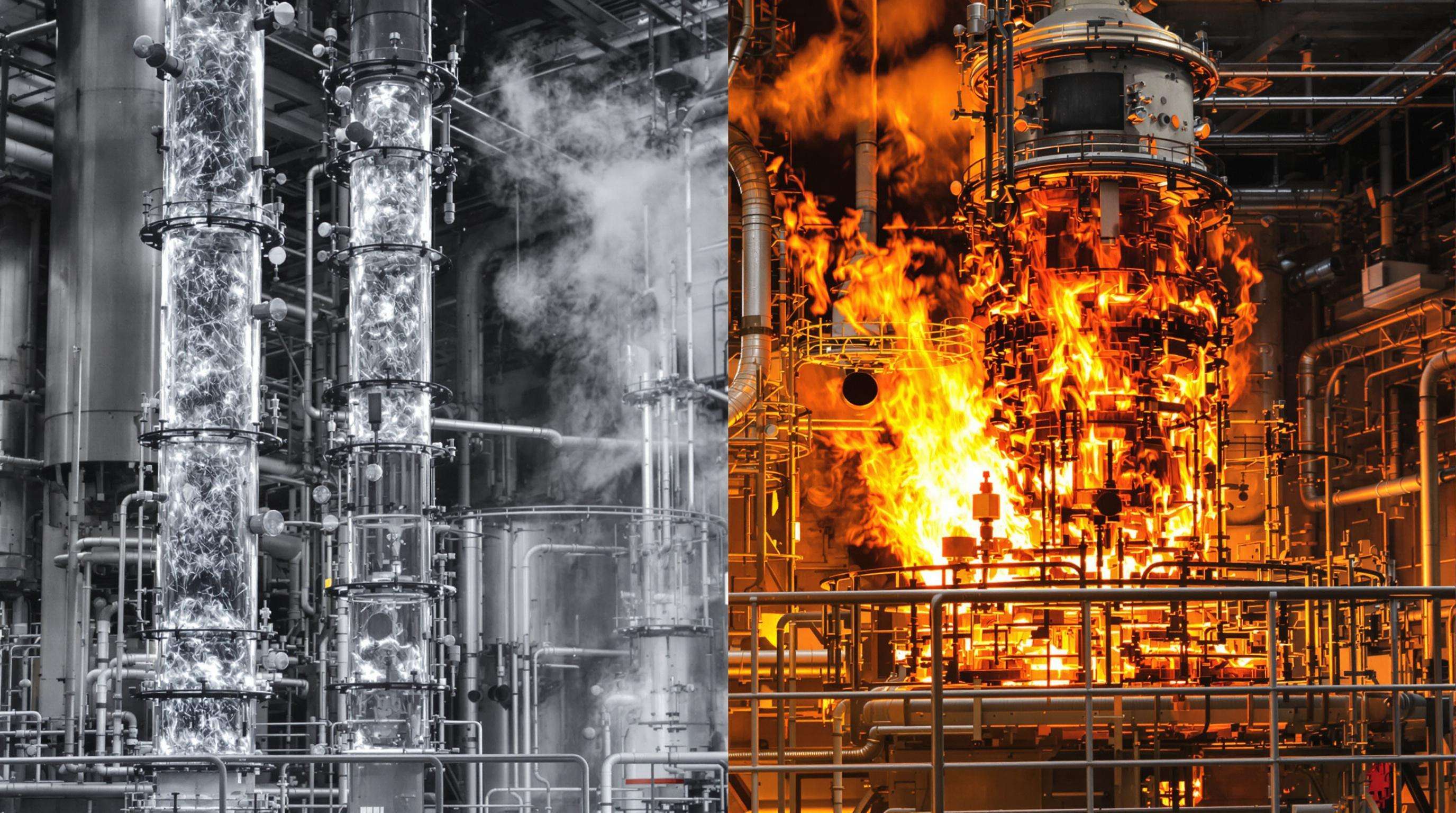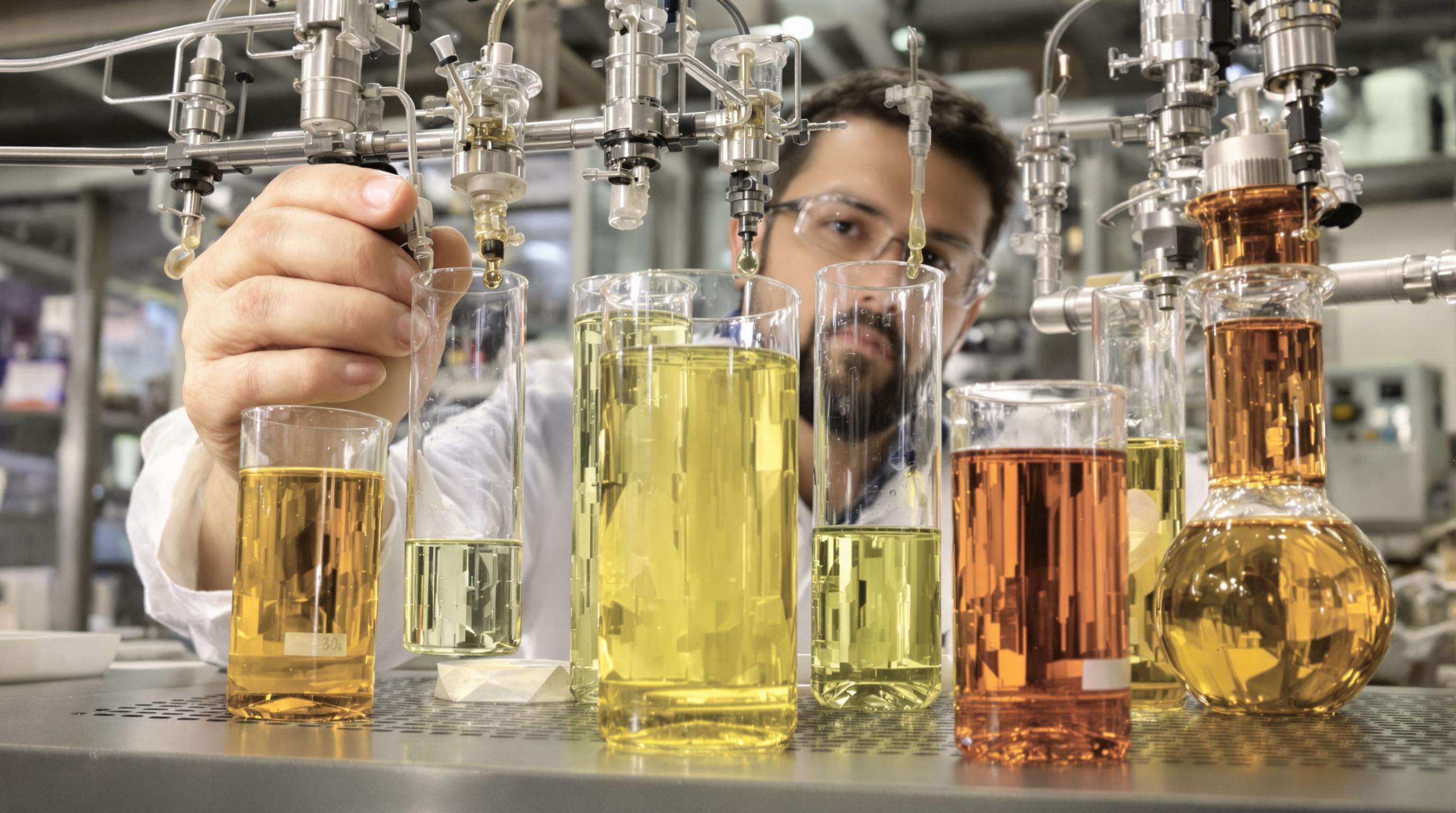
The process of crude oil distillation takes advantage of how different hydrocarbons boil at various temperatures to split them apart using what's called fractional distillation. Light stuff like naphtha tends to turn into vapor around 35 to maybe 200 degrees Celsius, whereas the heavier parts stay liquid when temps go past about 550 degrees. These days, many refineries run their vacuum distillation units under pressures lower than 50 millibars. This pressure drop actually cuts down the boiling points by roughly 300 degrees, which helps prevent damage from excessive heat. What makes this method so effective is that it can produce initial distillates with purity levels reaching nearly 95 percent, all without changing the actual molecular makeup of the components being separated.
The process of pyrolysis basically works by heating materials between around 400 to 800 degrees Celsius which breaks down those carbon-carbon and carbon-hydrogen bonds through these radical chain reactions. This transforms heavier substances into lighter hydrocarbon products. What makes pyrolysis different from distillation is that it actually changes the molecules themselves in a way that can't be undone. When things get up to about 750 degrees Celsius, we see peak production of ethylene and methane thanks to what's called beta scission. But if temperatures go past 1,000 degrees, something else happens - the material starts to turn into graphite instead, which means less liquid product comes out at the end. Getting the temperature just right matters a lot for producing the most useful outputs possible from this process.
In a 2021 paper published in the Journal of Petroleum Exploration and Production, researchers looked at how traditional atmospheric distillation units that process around 250,000 barrels per day of crude oil stack up against newer modular pyrolysis systems dealing with just 500 tons per day of plastic waste. The distillation method managed to hit an impressive 82% energy efficiency when making gasoline. Meanwhile, the pyrolysis approach only got to 58% efficiency, though it had the advantage of working exclusively with post-consumer plastic materials. What makes this interesting is that after some hydrotreatment processing, these pyrolysis oils actually worked well enough to blend into FCC units at rates between 15 and 20%. This means plants could cut down their need for fresh naphtha by approximately 12,000 cubic meters each year, which represents a significant cost saving for refiners looking to incorporate recycled materials into their operations.
The distillation process works most effectively when dealing with crude oil feedstocks that have consistent boiling points and minimal carbon residue. This makes it easier to separate the mixture into valuable products like naphtha, diesel fuel, and various residual fractions. On the other hand, pyrolysis technology really shines with materials that can be cracked easily, which depends largely on how branched the molecules are and their hydrogen to carbon ratios. Take polyolefin based plastics as an example these materials typically convert around 75 to 85 percent into useful chemicals like ethylene and propylene during pyrolysis according to research from NREL back in 2022. That's actually better than what we see with the straight chain alkanes found commonly in traditional crude oil sources.
Pyrolysis oils from waste plastics or biomass contain 0.5–3.2% oxygen and 0.1–1.8% sulfur by weight, necessitating costly hydrotreatment before refining. Chlorinated additives in plastics generate corrosive HCl, requiring specialized reactor materials and gas scrubbing systems. In contrast, sulfur in crude oil distillation concentrates in heavier fractions, simplifying management in downstream units.
Traditional petroleum feedstocks have this really consistent makeup that works great for distillation processes. Pyrolysis oils on the other hand bring something different to the table since they can turn all sorts of mixed waste materials into usable hydrocarbons. Some recent research back in 2024 looked at Fluid Catalytic Cracking systems and discovered that when refiners mix about 10% pyrolysis oil with vacuum gas oil, it actually cuts down on coke formation by roughly 18%, which is pretty impressive considering yields stay about the same. There's still a problem though with these pyrolysis oils containing all sorts of variable contaminants. Refineries were built to handle stable crude inputs, but those pesky residual catalysts left over from depolymerization processes make widespread adoption tricky for most existing facilities.
When steam crackers work with naphtha feedstocks, they generally produce around 25 to 30 percent light olefins because the material has a stable composition and operates under well-controlled conditions. Things get trickier with pyrolysis oils though. Even after going through hydrotreatment processes, these materials usually only give about 15 to 20 percent light olefins. Why? Mainly because their molecular structures vary quite a bit and they often contain impurities such as chlorides. A recent report from the Petrochemical Innovation Consortium in 2023 showed something interesting too. To get the same amount of ethylene production as naphtha, pyrolysis oils need cracking temperatures that are roughly 10 to 15 percent higher. This temperature difference makes a real impact on operational costs and efficiency for many plants.
Pyrolysis oils contain 1–3% sulfur and oxygenates, significantly higher than the <0.5% in distilled naphtha (NREL, 2022). These impurities accelerate coking and corrosion, shortening reactor lifespan by 40–60% in pilot tests. Retrofitting with advanced sulfur scrubbers and dual-stage quenching improves tolerance, but full-scale upgrades exceed $18 million in capital costs.
The costs for pyrolysis feedstocks sit around $20 to $40 per ton when dealing with waste plastics, which is way cheaper compared to the $600 to $800 per ton price tag for distilled naphtha. But there's a catch worth mentioning here. The process itself actually eats up 30 to 50 percent more energy per ton produced, so it only makes financial sense when feedstock stays below about $55 per ton. According to some modeling work from the Energy Transition Institute, mixing bio-oils into FCC units cuts down on overall energy needs by roughly 22%. This helps improve how well things stack up cost-wise while still keeping those yields stable enough for most operations.
The process of pyrolysis really helps move us toward circular economy principles because it turns those stubborn non-recyclable plastics and old rubber stuff into something useful again - basically hydrocarbons that regular distillation methods just can't handle. About 85% of all that plastic trash gets recovered through this method, which means way less going to landfills. Plus, the oils produced have pretty decent energy content around 38 to 45 MJ per kilogram, similar to what we see in standard naphtha products. Some new catalyst developments are making things even better. Materials like red mud or these Co/SBA-15 compounds help bring down sulfur levels to under 0.5 weight percent, so they work much better when mixed with other chemical recycling processes. We've seen some tests where medical grade plastic waste was converted successfully, showing that pyrolysis could replace roughly 20 to 30% of traditional fossil fuels in FCC units. Still, most refineries struggle with this technology though. Less than half actually manage to process pyrolysis oils or bio-oils alongside their regular operations without needing expensive equipment upgrades first.
The high limonene and BTX content in pyrolysis oil makes it suitable for producing virgin-grade polymers. Processing one ton of waste tires yields 450–600 kg of oil, sufficient to replace 30% of crude-derived feedstocks in styrene production.
Zeolite-based catalysts achieve 80% polyolefin conversion to light olefins at 500°C, with four times greater contaminant tolerance than thermal pyrolysis. This reduces preprocessing costs by $40–60 per ton, improving scalability.
Blending 10% pyrolysis oil with vacuum gas oil increases propylene yield by 12%. However, chloride levels above 50 ppm pose corrosion risks, requiring $2–4 million in reactor upgrades for safe integration.

The way products distribute during pyrolysis really hinges on three main factors: temperature which typically ranges from around 450 to 800 degrees Celsius, pressure conditions that can vary from normal atmospheric levels down to moderate vacuum settings, and how long the materials stay in the reactor, usually between half a second and thirty seconds. When we crank up the heat, we get more gases produced, particularly seeing about 15 to 20 percent yield of ethylene and propylene. For those looking to maximize liquid oil output, temperatures around 500 to 650 degrees seem to work best. Keeping things moving quickly through the process helps maintain heavier compounds such as waxes because it stops them from breaking down further. But leave stuff too long in there and those complicated molecules just keep getting broken apart into smaller, less stable components that aren't as useful commercially.
Catalysts such as ZSM-5 zeolites or alumina-silicates improve selectivity by 15–40%, steering decomposition toward desired products. Acid catalysts enhance light olefin yield (65–80% ethylene selectivity) and suppress oxygenates in biomass feeds. Co-pyrolyzing plastics with biomass reduces wax viscosity by 30%, improving compatibility with existing refining infrastructure.
The hydrotreatment process takes out about 90 to 95 percent of the oxygen and sulfur content in pyrolysis oil, which helps stabilize it somewhat close to what we see in distilled crude fractions. But there's a catch here. Even after treatment, these oils still have around two or even three times more aromatic compounds compared to regular virgin naphtha, so they can't really be used straight away for things like polyolefin manufacturing unless they undergo additional processing. Distilled crude oil works pretty well with existing infrastructure, but when we look at upgraded pyrolysis oils, they actually bring something different to the table. Their molecules are more varied, which opens up possibilities for some niche applications such as creating precursors for carbon fibers. That kind of versatility makes them interesting despite the challenges involved in working with them.
Distillation is a physical separation process that utilizes boiling point differences to separate hydrocarbons, leaving the molecular structure unchanged. Pyrolysis, on the other hand, involves thermal decomposition, changing the molecular structures permanently through radical chain reactions.
Pyrolysis contributes to sustainability by converting non-recyclable plastics and waste material into usable hydrocarbons, thus reducing landfill waste and supporting circular economy principles.
Pyrolysis oils contain variable contaminants and impurities, such as high levels of sulfur and chlorides, making them less stable and requiring costly retrofitting of existing distillation systems to handle these impurities effectively.
 Hot News
Hot News2024-09-25
2024-09-18
2024-09-12
2024-09-05
2024-08-30
2024-08-23

Copyright © 2025 by Shangqiu AOTEWEI environmental protection equipment Co.,LTD Privacy policy